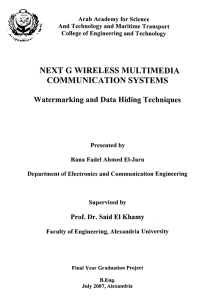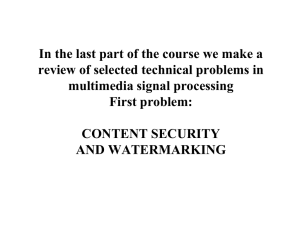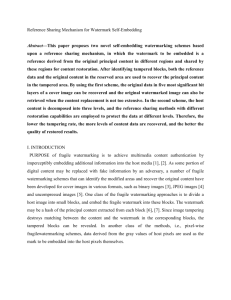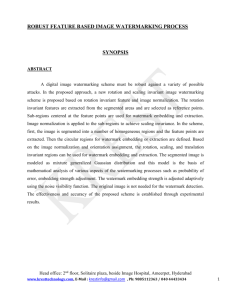Research Journal of Applied Sciences, Engineering and Technology 5(5): 1731-1735,... ISSN: 2040-7459; e-ISSN: 2040-7467
advertisement
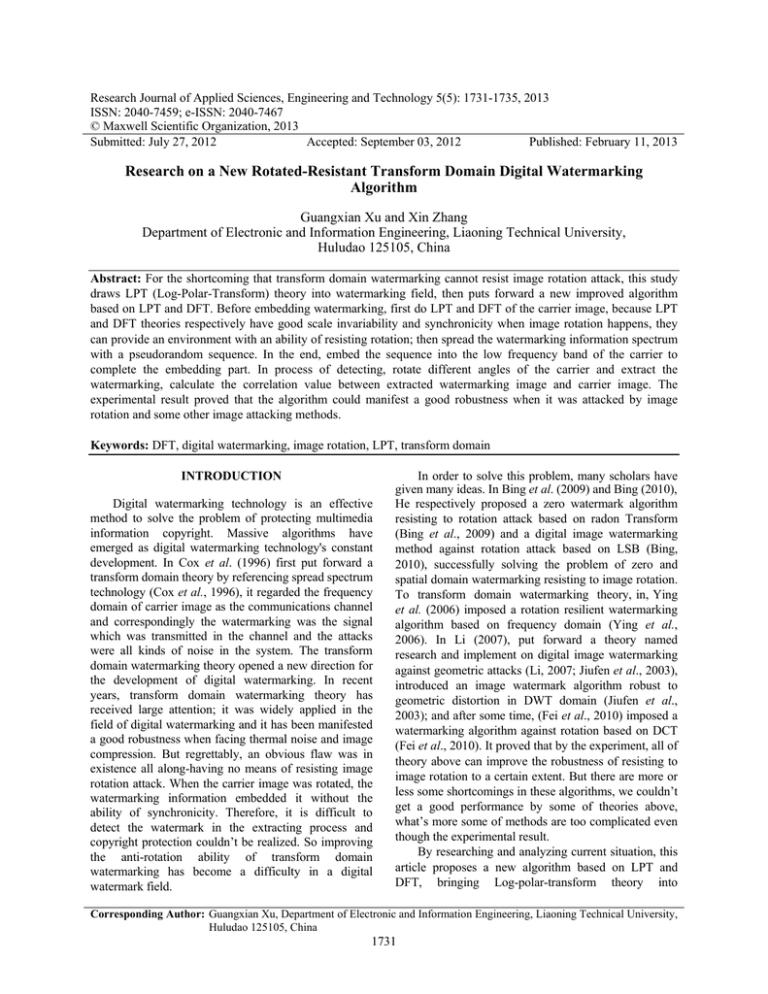
Research Journal of Applied Sciences, Engineering and Technology 5(5): 1731-1735, 2013 ISSN: 2040-7459; e-ISSN: 2040-7467 © Maxwell Scientific Organization, 2013 Submitted: July 27, 2012 Accepted: September 03, 2012 Published: February 11, 2013 Research on a New Rotated-Resistant Transform Domain Digital Watermarking Algorithm Guangxian Xu and Xin Zhang Department of Electronic and Information Engineering, Liaoning Technical University, Huludao 125105, China Abstract: For the shortcoming that transform domain watermarking cannot resist image rotation attack, this study draws LPT (Log-Polar-Transform) theory into watermarking field, then puts forward a new improved algorithm based on LPT and DFT. Before embedding watermarking, first do LPT and DFT of the carrier image, because LPT and DFT theories respectively have good scale invariability and synchronicity when image rotation happens, they can provide an environment with an ability of resisting rotation; then spread the watermarking information spectrum with a pseudorandom sequence. In the end, embed the sequence into the low frequency band of the carrier to complete the embedding part. In process of detecting, rotate different angles of the carrier and extract the watermarking, calculate the correlation value between extracted watermarking image and carrier image. The experimental result proved that the algorithm could manifest a good robustness when it was attacked by image rotation and some other image attacking methods. Keywords: DFT, digital watermarking, image rotation, LPT, transform domain INTRODUCTION Digital watermarking technology is an effective method to solve the problem of protecting multimedia information copyright. Massive algorithms have emerged as digital watermarking technology's constant development. In Cox et al. (1996) first put forward a transform domain theory by referencing spread spectrum technology (Cox et al., 1996), it regarded the frequency domain of carrier image as the communications channel and correspondingly the watermarking was the signal which was transmitted in the channel and the attacks were all kinds of noise in the system. The transform domain watermarking theory opened a new direction for the development of digital watermarking. In recent years, transform domain watermarking theory has received large attention; it was widely applied in the field of digital watermarking and it has been manifested a good robustness when facing thermal noise and image compression. But regrettably, an obvious flaw was in existence all along-having no means of resisting image rotation attack. When the carrier image was rotated, the watermarking information embedded it without the ability of synchronicity. Therefore, it is difficult to detect the watermark in the extracting process and copyright protection couldn’t be realized. So improving the anti-rotation ability of transform domain watermarking has become a difficulty in a digital watermark field. In order to solve this problem, many scholars have given many ideas. In Bing et al. (2009) and Bing (2010), He respectively proposed a zero watermark algorithm resisting to rotation attack based on radon Transform (Bing et al., 2009) and a digital image watermarking method against rotation attack based on LSB (Bing, 2010), successfully solving the problem of zero and spatial domain watermarking resisting to image rotation. To transform domain watermarking theory, in, Ying et al. (2006) imposed a rotation resilient watermarking algorithm based on frequency domain (Ying et al., 2006). In Li (2007), put forward a theory named research and implement on digital image watermarking against geometric attacks (Li, 2007; Jiufen et al., 2003), introduced an image watermark algorithm robust to geometric distortion in DWT domain (Jiufen et al., 2003); and after some time, (Fei et al., 2010) imposed a watermarking algorithm against rotation based on DCT (Fei et al., 2010). It proved that by the experiment, all of theory above can improve the robustness of resisting to image rotation to a certain extent. But there are more or less some shortcomings in these algorithms, we couldn’t get a good performance by some of theories above, what’s more some of methods are too complicated even though the experimental result. By researching and analyzing current situation, this article proposes a new algorithm based on LPT and DFT, bringing Log-polar-transform theory into Corresponding Author: Guangxian Xu, Department of Electronic and Information Engineering, Liaoning Technical University, Huludao 125105, China 1731 Res. J. Appl. Sci. Eng. Technol., 5(5): 1731-1735, 2013 transform domain watermarking. We need to do LPT and DFT of carrier image before embed watermarking information. Owing to scale invariability and synchronicity they have, it make sure that the carrier image can hold the same ability, if we embed the watermarking into it, then no matter what angle the carrier rotates, it can extract a clear watermarking image. At the same time, this algorithm is fairly simple to implement, we could save lots of time and programs when achieve it. LOG-POLAR-TRANSFORM THEORY Log-polar-transform derives from the research on human visual mechanism (Bo et al., 2008). Any pixel I of the image could be expressed with Cartesian coordinate I (x, y) and it can also be indicated in Polar coordinate form I(r, ), then the definition of the LPT from between I(x, y) and I(r, ) is: (1) r log ( x x) 2 ( y y) 2 arctan( y y ) x x (2) In the formula (1) and (2), (r, ) are polar radius and polar angle of log polar coordinate? (x', y') is the selected coordinate origin. If we choose the origin (0, 0), they would meet the relation as formula (3): 1 log kr log k log r 1 In formula (7), the scale varies k times, the image downward moves units; in terms of angle, when rotate , it will parallel moves units in angle axes of the log polar coordinates. Obviously, scale and angle moving in Cartesian coordinate leads to the parallel moving along the polar radius r and polar anglein log polar coordinate, so the LPT has an advantage of scale invariability when rotated. RESEARCH ON EMBEDDED AND EXTRACTED PROCESS OF WATERMARKING The embedded process: The embedded process of watermarking is as follows: y x r ( x2 y 2 ) , arctan( ) (3) It can be expressed in the complex plane: z x iy r (cos i sin ) re i (4) And the LPT is: w log( z ) log( re ) log r i (5) According to formula (5) we can make a conclusion that scale axes are independent of the angle axes: log r , Let the carrier image be P (x, y) and do LPT of P (x, y), the image after transform is G (x, y) Do 8×8 blocking of G (x, y), then we can get m sub-blocks Carry out each block 2 d DFT Spread the spectrum of watermarking image with pseudo-random sequence n, we could get a group of sequence code of period m Calculating the DFT coefficient of each block and embedding the sequence into the middle frequency band of each block, the principal is as follows: H i¢( x , y ) = H i ( x , y ) + a w i ( x , y ) L i ( x , y ) (8) Hi (x, y) is the DFT coefficient of the i-th sub-block in the region (x, y). H′i (x, y) is the DFT coefficient after embedded watermarking. wi ( x, y ) is the watermarking sequence embedded into the carrier, α is embedded strength; it could be expressed by the formula (9): wi ( x, y ) = I i ni ( x, y ) i (7) (6) If taking point of fixation as the center zoom k times and rotate , we can get: 1732 (9) Ii is the i-th value of the watermarking image matrix and ni (x, y) is the value of sequence n which is in the i-th blocks, Li (x, y) stands a brightness shield characteristic threshold of HVS in position (x, y), within this threshold, the embedded effect could achieve the best by the way of moderating appropriately (Jing and Xiangyang, 2011). This method could avoid that the overlarge embedded strength affecting the result just like traditional watermarking theory. Res. J. Appl. A Sci. Eng. Technol., 5(5): 1731-1735, 2013 2 Fig. 1: The whole w embedded d process (a) Fig. 2: Carriier image Fig. 3: Wateermarking imagee (b) (c) (d) Fig. 5: R Rotate watermarrked image, (a) rotate r 30°, (b) rootate 4 (c) rotate 600°, (d) rotate 90°° 45°, Fig. 4: Wateermarking imagee Do ID DFT and ILPT to reconstructt the image, thhen we geet the waterm marked image G′ (x, y). The T embeddded process iss as follows as Fig. 1. (a) (b) The extraccted process: Extracting wattermarking is the t counter proocess to embed dding: Do LP PT of image G′′ (x, y) Do DF FT of image G′ G (x, y) and carry out it 8×8 blockiing (c) (d) Find the watermark king sequencee from the suubblockiings and extraccted them Fig. 6: Extract E watermaarking after rotatte, (a) rotate 30°,, (b) r rotate 45°, (c) rootate 60°, (d) rotaate 90° Get thhe image matrix x by de-spreading the sequennce 1733 Res. J. Appl. A Sci. Eng. Technol., 5(5): 1731-1735, 2013 2 Table 1: NC value v after image rotation r (Qiyang and a Baolin, 2009) Rotate Jiufen et al. Fei et al. angle N NC Li (2 2007) (2003)) (2010) 30° 0..9033 0.85 556 0.86622 0.9011 45° 0..8758 0.85 586 0.84155 0.8535 60° 0..9012 0.86 621 0. 85933 0.9147 90° 0..9671 0.94 458 0.95877 0.9735 Table 2: NC value v after image rotation r Attack methood Extracted imaage White noise NC 0.9871 Gaussian LPF F 0.9787 Image comprression 0.9835 Pepper noise 0.9812 Affine transfoorm 0.9618 Enlarge - Reduce - Histogram eqqualization 05166 Change contrrast 0.3945 Noo matter whatt angles the watermarked image rotated, the extraccted watermaarking imagess are relativeely clear. We can get the conclusion thaat this algorithhm has a goood robustness. By means of o the experim ment, it provedd that NC valuue is bigger thhan the one in Li (2007) and Jiufen et al. (22003) in most cases. i Fei et al. (2010) ( is betteer to a Althouggh the result in certain extent, the algorithm wee propose is much e to undderstand. Undeer the simplerr and more easily similar circumstances, if take the theory in Fei et al. (2010),, it will cost muuch more spacce, time and code. So we put forward this algorithm. t other methhods to attack Fig. 4 Thhen we would take and thee NC value is shown s in Tablle 2. For enlargge and reduce attacks that the size of waterrmarking is chaanged, o the exxperiment resuult directly insttead of so we observed calculaating the NC vaalue. Wee learned from m Table 2 thatt this algorithm m can resist many m image attacks, a but reegrettably, oncce the waterm marking was attacked a by chhanging contrrast or histogram equalizatiion, the extraacted watermarking would emerge obvioous distortion, so we will go on doing some s research on o this shortcooming. C CONCLUSION N Reconnstruct the wattermarking im mage in the rigght order EXPERIME ENTAL RESU ULTS Choossing a Couple images whosee size is 512×5512 as the carrrier image, which w is shownn in Fig. 2. The T watermarkking image iss a 64×64 binary b image as follows as Fig. 3. Embed d it into the caarrier by the way w ntroduced aboove and get the t of the alggorithm we in watermarkked image as in n Fig. 4 We beegin to attack Fig. 4, rotate it with differeent angles as shown in Fiig. 5, accordiing to extractted w a after attack is in method, thhe extracted watermarking Fig. 6. k out the NC value based on De-nooise and work formula (10): å NC= I 2 ( x, y ) x, y å (110) I ( x , y ) I ¢( x , y ) x, y u to represeent the similarrity between the t It is used original waatermarking an nd extracted waatermarking. The T bigger NC C value is, the more similar is and the bettter robustness will be, the NC N value is shhown in Tablee 1 9). (Qiyang annd Baolin, 2009 Acccording to diggital watermarkking, combining with Log-poolar-transform theory, this stuudy proposed a new transforrm domain watermarking w a algorithm whicch has the abiility of resistinng image rotattion. It provedd with experim ment that the algorithm inn this article could improvve the robustness to geometricc attack of trannsform domainn watermarkinng, but once facing some other attacks, there are som me limitations in this algorithhm, so the authhor will do furtther research. R REFERENCES S H 2010. A diggital iimage watermarking w m method Bing, H., agaainst rotation attack based on o LSB. Syst. Smul. Teechnol., 6(4): 304-307. Bing, H., H W. Xuan and a Z. Jie, 2009. Zero wateermark alggorithms resistting to rotatioon attack based on raddon transform. Comput. Eng., 35(16): 128-1132. Bo, Y., G. Lei and Z. Z TianYu, 20008. Gray projeecti on mage stabilizinng algorithm based on logg-polar im im mage transform m. Comput. Appl. 2 28(12): 3125-3128. I J. Kilian and T. Leigghton, 1996. Secure S Cox, I.J., sprread spectrum m watermarking for image, audio andd video. Prooceedings of IEEE Internaational Coonference in Image Proceessing. IEEE,, Los Alamitos, CA, 3:: 243-246. a Z. Min, 20010. A watermarking Fei, S.,, W. HuiQin and alggorithm againnst rotation based on DCT. Prooceedings of CIHW, C pp: 183-186. 1734 Res. J. Appl. Sci. Eng. Technol., 5(5): 1731-1735, 2013 Jing, W. and W. Xiangyang, 2011. Digital image watermark method based on human visual system. Comput. Eng., 37(13): 107-112. Jiufen, L., W.W. Zhen and H. Da Ren, 2003. Image watermark algorithm robust to geometric distortion in DWT domain. J. Zhejiang Univ., Eng. Sci., 37(4): 386-392. Li, Z., 2007. Research and implement on Digital Image Watermarking Against Geometric Attacks. Wuhan University of Technology. Qiyang, Z. and Y. Baolin, 2009. On the luminance overflow in spread spectrum robust image watermarking schemes. J. Comput. Res. Dev., 46(10): 1729-1735. Ying, D., Y. Yuan and Y. Daohua, 2006. Rotation resiiient watermarking aigorithm based on freguency domain. Appl. Res. Comput., 23(3): 79-81. 1735


